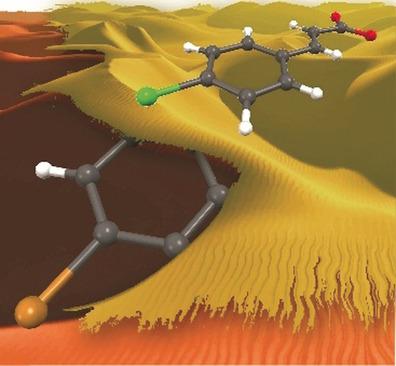当前位置:
X-MOL 学术
›
Angew. Chem. Int. Ed.
›
论文详情
Our official English website, www.x-mol.net, welcomes your feedback! (Note: you will need to create a separate account there.)
Probing the Crystal Structure Landscape by Doping: 4‐Bromo, 4‐Chloro, and 4‐Methylcinnamic Acids
Angewandte Chemie International Edition ( IF 16.1 ) Pub Date : 2018-07-04 , DOI: 10.1002/anie.201801649 Shaunak Chakraborty 1 , Sumy Joseph 1 , Gautam R. Desiraju 1
Angewandte Chemie International Edition ( IF 16.1 ) Pub Date : 2018-07-04 , DOI: 10.1002/anie.201801649 Shaunak Chakraborty 1 , Sumy Joseph 1 , Gautam R. Desiraju 1
Affiliation

|
Accessing the data points in the crystal structure landscape of a molecule is a challenging task, either experimentally or computationally. We have charted the crystal structure landscape of 4‐bromocinnamic acid (4BCA) experimentally and computationally: experimental doping is achieved with 4‐methylcinnamic acid (4MCA) to obtain new crystal structures; computational doping is performed with 4‐chlorocinnamic acid (4CCA) as a model system, because of the difficulties associated in parameterizing the Br atom. The landscape of 4CCA is explored experimentally in turn, also by doping it with 4MCA, and is found to bear a close resemblance to the landscape of 4BCA, justifying the ready miscibility of these two halogenated cinnamic acids to form solid solutions without any change in crystal structure. In effect, 4MCA, 4CCA and 4BCA form a commutable group of crystal structures, which may be realized experimentally or computationally, and constitute the landscape. Unlike the results obtained by Kitaigorodskii, all but two of the multiple solid solutions obtained in the methyl‐doping experiments take structures that are different from the hitherto observed crystal forms of the parent compounds. Even granted that the latter might be inherently polymorphic, this unusual observation provokes the suggestion that solid solution formation may be used to probe the crystal structure landscape. The influence of π⋅⋅⋅π interactions, weak hydrogen bonds and halogen bonds in directing the formation of these new structures is also seen.
中文翻译:

通过掺杂探查晶体结构态势:4-溴,4-氯和4-甲基肉桂酸
无论是实验还是计算,访问分子晶体结构图谱中的数据点都是一项艰巨的任务。我们通过实验和计算得出了4-溴肉桂酸(4BCA)的晶体结构图:用4-甲基肉桂酸(4MCA)进行实验掺杂以获得新的晶体结构;由于在参数化Br原子方面存在困难,因此使用4-氯肉桂酸(4CCA)作为模型系统进行计算掺杂。通过用4MCA掺杂也依次通过实验探索了4CCA的外观,发现它与4BCA的外观非常相似,证明了这两种卤化肉桂酸易于混溶以形成固溶体而晶体没有任何变化结构体。实际上,4MCA 4CCA和4BCA形成了一组可交换的晶体结构,可以通过实验或计算实现,并构成整体。与Kitaigorodskii获得的结果不同,在甲基掺杂实验中获得的多种固溶体中,除两种以外,所有固溶体的结构都不同于迄今观察到的母体化合物的晶体形式。即使考虑到后者可能是固有的多态性,这种不寻常的观察也提出了固溶体形成可用于探测晶体结构图景的建议。还可以看到π⋅⋅⋅π相互作用,弱氢键和卤素键对指导这些新结构形成的影响。与Kitaigorodskii获得的结果不同,在甲基掺杂实验中获得的多种固溶体中,除两种以外,所有固溶体的结构都不同于迄今观察到的母体化合物的晶体形式。即使考虑到后者可能是固有的多态性,这种不寻常的观察也提出了固溶体形成可用于探测晶体结构图景的建议。还可以看到π⋅⋅⋅π相互作用,弱氢键和卤素键对指导这些新结构形成的影响。与Kitaigorodskii获得的结果不同,在甲基掺杂实验中获得的多种固溶体中,除两种以外,所有固溶体的结构都不同于迄今观察到的母体化合物的晶体形式。即使考虑到后者可能是固有的多态性,这种不寻常的观察也提出了固溶体形成可用于探测晶体结构图景的建议。还可以看到π⋅⋅⋅π相互作用,弱氢键和卤素键对指导这些新结构形成的影响。这种不寻常的观察结果提出了这样的建议,即固溶体的形成可以用来探测晶体结构。还可以看到π⋅⋅⋅π相互作用,弱氢键和卤素键对指导这些新结构形成的影响。这种不寻常的观察结果提出了这样的建议,即固溶体的形成可以用来探测晶体结构。还可以看到π⋅⋅⋅π相互作用,弱氢键和卤素键对指导这些新结构形成的影响。
更新日期:2018-07-04
中文翻译:

通过掺杂探查晶体结构态势:4-溴,4-氯和4-甲基肉桂酸
无论是实验还是计算,访问分子晶体结构图谱中的数据点都是一项艰巨的任务。我们通过实验和计算得出了4-溴肉桂酸(4BCA)的晶体结构图:用4-甲基肉桂酸(4MCA)进行实验掺杂以获得新的晶体结构;由于在参数化Br原子方面存在困难,因此使用4-氯肉桂酸(4CCA)作为模型系统进行计算掺杂。通过用4MCA掺杂也依次通过实验探索了4CCA的外观,发现它与4BCA的外观非常相似,证明了这两种卤化肉桂酸易于混溶以形成固溶体而晶体没有任何变化结构体。实际上,4MCA 4CCA和4BCA形成了一组可交换的晶体结构,可以通过实验或计算实现,并构成整体。与Kitaigorodskii获得的结果不同,在甲基掺杂实验中获得的多种固溶体中,除两种以外,所有固溶体的结构都不同于迄今观察到的母体化合物的晶体形式。即使考虑到后者可能是固有的多态性,这种不寻常的观察也提出了固溶体形成可用于探测晶体结构图景的建议。还可以看到π⋅⋅⋅π相互作用,弱氢键和卤素键对指导这些新结构形成的影响。与Kitaigorodskii获得的结果不同,在甲基掺杂实验中获得的多种固溶体中,除两种以外,所有固溶体的结构都不同于迄今观察到的母体化合物的晶体形式。即使考虑到后者可能是固有的多态性,这种不寻常的观察也提出了固溶体形成可用于探测晶体结构图景的建议。还可以看到π⋅⋅⋅π相互作用,弱氢键和卤素键对指导这些新结构形成的影响。与Kitaigorodskii获得的结果不同,在甲基掺杂实验中获得的多种固溶体中,除两种以外,所有固溶体的结构都不同于迄今观察到的母体化合物的晶体形式。即使考虑到后者可能是固有的多态性,这种不寻常的观察也提出了固溶体形成可用于探测晶体结构图景的建议。还可以看到π⋅⋅⋅π相互作用,弱氢键和卤素键对指导这些新结构形成的影响。这种不寻常的观察结果提出了这样的建议,即固溶体的形成可以用来探测晶体结构。还可以看到π⋅⋅⋅π相互作用,弱氢键和卤素键对指导这些新结构形成的影响。这种不寻常的观察结果提出了这样的建议,即固溶体的形成可以用来探测晶体结构。还可以看到π⋅⋅⋅π相互作用,弱氢键和卤素键对指导这些新结构形成的影响。











































 京公网安备 11010802027423号
京公网安备 11010802027423号